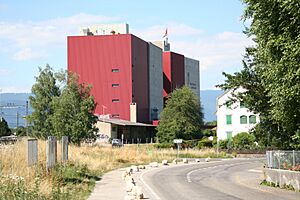Busswil bei Büren facts for kids
Quick facts for kids
Busswil bei Büren
|
||
|---|---|---|
|
||
| Country | Switzerland | |
| Canton | Bern | |
| District | Seeland | |
| Area | ||
| • Total | 3.10 km2 (1.20 sq mi) | |
| Elevation | 437 m (1,434 ft) | |
| Population | ||
| • Total | 1,905 | |
| • Density | 614.5/km2 (1,591.6/sq mi) | |
| Postal code |
3292
|
|
| Surrounded by | Büetigen, Lyss, Studen, Worben | |
Busswil bei Büren was once a small town, or municipality, in Switzerland. It was located in the canton of Bern, in an area called the Seeland administrative district. On January 1, 2011, Busswil bei Büren joined with the nearby town of Lyss.
Contents
Where is Busswil bei Büren located?
Busswil is found along the old Aare river. This part of the Aar river flows from Aarberg to Büren. Long ago, the river often flooded Busswil. People changed the river in the 1800s to stop these floods.
In ancient times, people from villages to the north used a path called "Obererer Weg." They traveled on this path to reach the market town of Lyss. There is also a very old oak tree in a field near Länggasse. People say that Napoleon and his soldiers rested there after a trip to Austria.
Busswil has several useful places for its residents. You can find a bakery, a post office, and two small supermarkets. There is also a tea-room, a hotel called Rössli, and a restaurant named Bahnhof. The town also has its own railway station.
The towns next to Busswil are Büetigen, Worben, Studen, and Lyss.
How big is Busswil bei Büren?
Busswil bei Büren covers an area of about 3.05 square kilometers (1.18 square miles). A large part of this land, about 51.5%, is used for farming. Forests cover about 28.5% of the area. Buildings and roads make up about 19.7% of the land.
A small amount of land, less than 1%, is rivers or lakes. Very little land, about 0.3%, is not used for anything.
Most of the built-up areas are homes and other buildings. Roads and transportation also take up some space. The forests are full of oak, birch, and beech trees. Farmers grow crops on much of the farmland. Some areas are also used for pastures or fruit trees.
The water in Busswil comes from rivers, streams, and underground springs. This spring water is very clean and used for drinking by some homes.
What is the population of Busswil bei Büren?
As of December 31, 2010, Busswil bei Büren had 1,905 people living there. About 11.7% of the people living in Busswil in 2007 were from other countries. Over ten years, the number of people living in Busswil grew by about 4.6%.
Most people in Busswil speak German, about 90.6%. French is the second most common language, spoken by 1.8% of the people. Italian is third, spoken by 1.7%.
How old are the people in Busswil?
In 2000, about 27.1% of the people were children and teenagers (0–19 years old). Adults (20–64 years old) made up 62.5% of the population. Older adults (over 64 years old) made up 10.4%.
Most people in Switzerland are well-educated. In Busswil bei Büren, about 72.6% of adults (aged 25-64) have finished high school or gone on to higher education. This includes universities or special colleges called Fachhochschules.
Busswil bei Büren has a low unemployment rate, about 1.21%. In 2005, a small number of people worked in farming. More people worked in manufacturing and construction. The largest number of people worked in the service industry, like shops and offices.
Besides the regular town government, there is also a special "citizen municipality." This group is made up of old families from the area. These families, like Bangerter, Eggli, Löffel, Stauffer, and Stebler, own a significant amount of land. This makes them important when new buildings are planned in the area.
See also
 In Spanish: Busswil bei Büren para niños
In Spanish: Busswil bei Büren para niños





